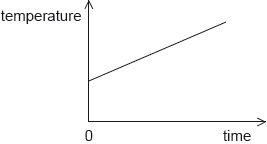| Date | May 2022 | Marks available | 2 | Reference code | 22M.2.SL.TZ1.2 |
| Level | Standard level | Paper | Paper 2 | Time zone | 1 |
| Command term | Outline | Question number | 2 | Adapted from | N/A |
Question
Cold milk enters a small sterilizing unit and flows over an electrical heating element.
The temperature of the milk is raised from 11 °C to 84 °C. A mass of 55 g of milk enters the sterilizing unit every second.
Specific heat capacity of milk = 3.9 kJ kg−1 K−1
The milk flows out through an insulated metal pipe. The pipe is at a temperature of 84 °C. A small section of the insulation has been removed from around the pipe.
Estimate the power input to the heating element. State an appropriate unit for your answer.
Outline whether your answer to (a) is likely to overestimate or underestimate the power input.
Discuss, with reference to the molecules in the liquid, the difference between milk at 11 °C and milk at 84 °C.
State how energy is transferred from the inside of the metal pipe to the outside of the metal pipe.
The missing section of insulation is 0.56 m long and the external radius of the pipe is 0.067 m. The emissivity of the pipe surface is 0.40. Determine the energy lost every second from the pipe surface. Ignore any absorption of radiation by the pipe surface.
Describe one other method by which significant amounts of energy can be transferred from the pipe to the surroundings.
Markscheme
energy required for milk entering in 1 s = mass x specific heat x 73 ✓
16 kW OR 16000 W ✓
MP1 is for substitution into mcΔT regardless of power of ten.
Allow any correct unit of power (such as J s-1 OR kJ s-1) if paired with an answer to the correct power of 10 for MP2.
Underestimate / more energy or power required ✓
because energy transferred as heat / thermal energy is lost «to surroundings or electrical components» ✓
Do not allow general term “energy” or “power” for MP2.
the temperature has increased so the internal energy / « average » KE «of the molecules» has increased OR temperature is proportional to average KE «of the molecules». ✓
«therefore» the «average» speed of the molecules or particles is higher OR more frequent collisions « between molecules » OR spacing between molecules has increased OR average force of collisions is higher OR intermolecular forces are less OR intermolecular bonds break and reform at a higher rate OR molecules are vibrating faster. ✓
conduction/conducting/conductor «through metal» ✓
use of where T = 357 K ✓
use of « = 0.236 m2» ✓
P = 87 «W» ✓
Allow 85 – 89 W for MP3.
Allow ECF for MP3.
convection «is likely to be a significant loss» ✓
«due to reduction in density of air near pipe surface» hot air rises «and is replaced by cooler air from elsewhere»
OR
«due to» conduction «of heat or thermal energy» from pipe to air ✓
Examiners report
Most candidates recognized that this was a specific heat question and set up a proper calculation, but many struggled to match their answer to an appropriate unit. A common mistake was to leave the answer in some form of an energy unit and others did not match the power of ten of the unit to their answer (e.g. 16 W).
Many candidates recognized that this was an underestimate of the total energy but failed to provide an adequate reason. Many gave generic responses (such as "some power will be lost"/not 100% efficient) without discussing the specific form of energy lost (e.g. heat energy).
This was generally well answered. Most HL candidates linked the increase in temperature to the increase in the kinetic energy of the molecules and were able to come up with a consequence of this change (such as the molecules moving faster). SL candidates tended to focus more on consequences, often neglecting to mention the change in KE.
Many candidates recognized that heat transfer by conduction was the correct response. This was a "state" question, so candidates were not required to go beyond this.
Candidates at both levels were able to recognize that this was a blackbody radiation question. One common mistake candidates made was not calculating the area of a cylinder properly. It is important to remind candidates that they are expected to know how to calculate areas and volumes for basic geometric shapes. Other common errors included the use of T in Celsius and neglecting to raise T ^4. Examiners awarded a large number of ECF marks for candidates who clearly showed work but made these fundamental errors.
A few candidates recognized that convection was the third source of heat loss, although few managed to describe the mechanism of convection properly for MP2. Some candidates did not read the question carefully and instead wrote about methods to increase the rate of heat loss (such as removing more insulation or decreasing the temperature of the environment).


